Recent events in Beirut have reminded the world of the Chernobyl disaster. It turns out, however, that many times in history there have been tragic catastrophes caused by carelessness and greed. Here are the 7 most important of them.
Greed, neglect and human error - these are the most common causes of industrial disasters, which have caused the world thousands of victims. Unfortunately, we still do not draw conclusions from the past.
1. Chernobyl
This is perhaps the most famous industrial disaster in the world, which was recently popularized by the sensational miniseries from HBO History. Around the memorable event of April 26, 1986, a peculiar pop-culture mythology arose, sustained by shocking reportages, fiction books, and even computer games. The causes of the catastrophe, as a result of which one of the four RM reactors exploded

The Chernobyl outbreak remains the most famous catastrophe to this day. It turns out, however, that there have been many more disasters with similar or worse consequences
The BK-1000 of the Chernobyl Nuclear Power Plant was typical to the bone: the most unstable factor, that is, the human, failed.
In fact, the RBMK-1000 reactors have never met Western safety standards. Admittedly, they were economical because they used graphite-moderated uranium as fuel, which, however, made them unstable. Not without impact was also the lack of something like a security culture in the Soviet Union, where efficiency and propaganda were translated over the basic principles of health and safety and human life.
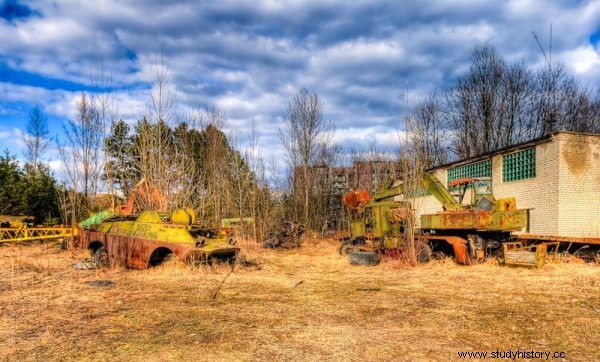
BRDM-2 wreck in Pripyat
Serious mistakes were made during the construction of the RBMK reactors. on concealing the details of their construction, even for specialists working there. The cooling system was also insufficient in the event of a failure of the entire core. The builders of the reactor in question did not seem to acknowledge this possibility (the cooling system was designed to cool only a part of the core in the reactor).
Another problem was the lack of a safety enclosure in the Chernobyl power plant, which was to limit the possible effects of the explosion. In addition, in the RBMK reactor, it was possible to disconnect the reactor's safety system, which at the time of the failure, by conducting an experiment aimed at paradoxically increasing safety, was done without realizing the consequences of its actions.
The effects of the failure are generally known, although depending on the source, they vary in scale. According to some data, the number of fatalities is 31, according to others, out of 134 employees involved in the liquidation of the accident, 35 people died by radiation sickness by 2004. However, taking into account the total number of people exposed to increased radiation, according to the report of Doctors Against Nuclear War, it is considered that the effects of the accident are still felt in Ukraine alone from a million to two million inhabitants . The natural environment also suffered. Huge areas were contaminated, and to this day the increased radiation in some areas around the city of Pripyat is dangerous to life.
2. Bhopal
The disaster at a chemical plant owned by the American company Union Carbide in the Indian city of Bhopal, although directly killed more people than the Chernobyl accident , it is still not widely disseminated in the public consciousness. One can only guess why:the question of geographic distance and the fact that it happened in one of the "Third World" countries; the American corporation behind it, which made sure that their PR gold-plated did not suffer too much; most of the victims come from the poorest social strata, i.e. those for whom the world does not shed much tears ...
The tragedy occurred on the night of December 2-3, 1984, when one of the tanks in which highly toxic pesticides were stored, namely methyl isocyanate, became unsealed and the lethal substance leaked out. Like all catastrophes of this type, it was due to human greed. The investigation carried out after the tragedy revealed many years of gross negligence at every possible level of security:from insufficient training of employees who did not know the basics of the English language (it was cynical to post all instructions in the plant in English), to broken installations preventing water from entering the reservoir with chemicals, to the tragic state of an overfilled container, where these pesticides were stored for years.
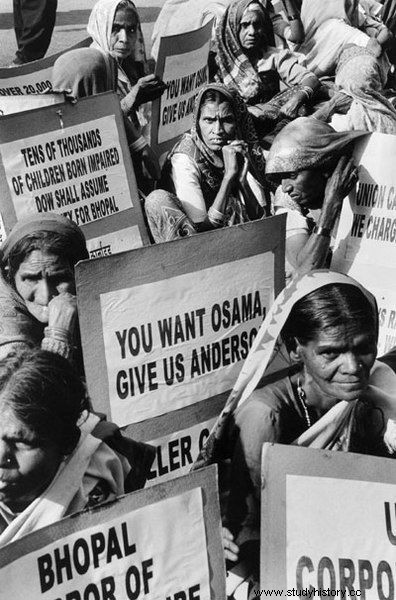
Bhopal disaster victims protest
As I mentioned, the system of pipelines and locks in Bhopal to prevent mixing of isocyanate with water was not working, because a chemical reaction took place that turned the isocyanate into a gas heavier than air. On the tragic night, the rusty vat finally became so damaged that dangerous substances began to spill over the surrounding, densely populated area. The balance was terrifying. About 4,000 people died almost immediately. It was only after the poisonous gas had spread over an area 25 kilometers in diameter that an alarm was raised at the factory. Meanwhile, Dantesque scenes were taking place in the city. People fled in panic and returned en masse to hospitals where it was not known what had happened at all.
Victims suddenly began to blind and choke, dying in agony. It is estimated that another 20,000 people died shortly after the disaster, moreover 120,000 suffered permanent health impairment, and another 50,000 were diagnosed with incapacity for work. The worst in this history is the insensitivity of the world and the impunity of large Western corporations treating countries like India like an animal farm. The compensation paid was ridiculous, and the contamination of the environment around the closed, decaying factory in some places exceeds all standards a thousand times.
Even more than 30 years after the tragic night, toxins take their toll on the local population, various diseases and cancers are massively present, and genetically ill children are born, whose lives are written off from the very beginning. To date, the US government and the company that bought Unite Carbide have been successfully avoiding any liability.
3. Kurenivska disaster
The word "catastrophe" was almost forbidden within the borders of the USSR. In a country of proletarian equality, prosperity and happiness, tragedies did not happen, and when it does, it is certainly the culprit of a creeping counter-revolution or capitalist agency. So when in a district of Kiev called Kurenivka, on March 13, 1961, a 14-meter-high and 60-meter-wide mudslide flooded the surrounding buildings and an overcrowded tram, burying people alive, the matter was covered up . After all, such an incident could not have happened in the USSR ...
In the said district, in a place called Babi Jar, where during the Second World War the Germans massacred the local population, it was decided to set up a waste storage facility from the production of bricks. Over a decade, over 4 million cubic meters of sediment consisting of ground bricks, water and rock were stored in the huge "lake", which formed post-production pulp. It was separated from the residential area only by an earth embankment, which from time to time leaked, and with time the garbage began to overflow overhead here and there.
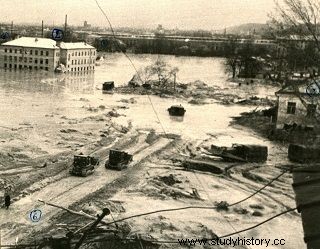
Kurenivska disaster
On March 13, 1961, around 9.20am, an avalanche suddenly passed through a fragile obstacle. All information about the disaster was immediately censored, and the area itself was surrounded by a military cordon. Censorship was so effective that even in Kiev itself, no one knew exactly what happened in Kurenivka. Even flights on airplanes near the crash site were banned. Nobody was supposed to know about it. The communist authorities were meticulous enough to leak information about the catastrophe only after 40 years (sic!).
The crash site was quickly cleaned up. The human remains protruding from under the mud and stones were completely ignored. The victims themselves were not accurately recorded, the death certificates from March 1961 were lost, and two-story apartment blocks were built on the scene. Years later, the death of 145 people was officially announced. According to unofficial information, however, the number of deaths ranged between 1,500 and 2,000. The bodies were buried in different cemeteries away from Kiev, often with different dates of death. Among others, two groups of preschoolers, all passengers of an overcrowded tram, lots of onlookers and people trapped in houses . The city stadium standing in the path of the avalanche absorbed the impact to some extent, so the damage was not even greater.
4. The Kysztym disaster
The nuclear incident that took place on September 29, 1957 in Mayak, one of the largest nuclear plants in the USSR, was named with this name. The name comes from the nearest "normal" city, which was then Kysztym, despite the fact that Oziorsk is closer. However, during the communist regime it was a closed city - unmarked on the map with limited or no access from outside.
The Mayak plant was part of the Soviet nuclear weapons research program, which refined and processed military plutonium, later specialized in the treatment of radioactive waste. The complex was built after the Second World War. The plants were spread over an area of almost 90,000 square kilometers and employed up to 17,000 workers living in the aforementioned closed city.
The first reactor in the USSR was built in Majak, put into operation on June 19, 1948. The first Soviet nuclear bomb was also manufactured there, detonated on August 29, 1949 at the Semipalatinsk proving ground. Initially, all liquid waste was poured directly into the River Tecza, which flowed through the Iset, Tobol, Irtysh and Ob into the Kara Sea. Then the waste was poured into Lake Karachay and other natural reservoirs, of which there was a lot around.
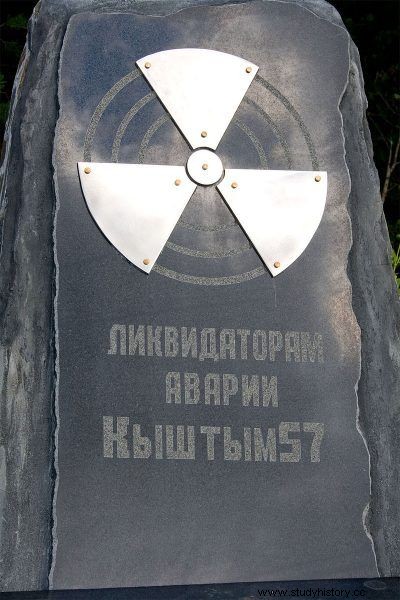
Monument to the victims of the Kysztym catastrophe
Over the years, almost all the surrounding lakes have been contaminated to a greater or lesser extent, which in the near future threatens with an ecological disaster on an unimaginable scale, incomparable to any other. To this day, a lot of waste is stored in special metal and concrete containers, some of which are progressively unsealed.
Over the years, due to a lack of imagination and, as in the case of the two above-mentioned catastrophes, in the territory of the former USSR - the immensity of human stupidity, there have been uncontrolled releases of radiation in Mayak, but the September 1957 accident was the largest. The immediate cause was the failure of the cooling system of the tank containing thousands of tons of nuclear waste. Without refrigerant, the radioactive compounds were heated and a non-nuclear explosion, as a result of which almost 40,000 square kilometers of land were covered with radioactive contamination.
The most contaminated regions:Chelyabinsk, Świerdłowski and Tyumenski are called the East Ural Radioactive Trail. According to data presented on various websites, about 200 people died of radiation sickness as a result of the catastrophe, 10,000 were evacuated, and 470,000 were exposed to the effects of ionizing radiation. To date, more than half a million civilians are expected to suffer. The government of the USSR, of course, completely ignored the threat, and mass hysteria erupted - allegedly, victims were seen dripping their skin. The example of the village of Muslimovo, which was evacuated only in ... 2005, may be symptomatic and gives some idea of the effectiveness of the authorities' actions.
Even more frightening is the fact that, according to declassified CIA data, the US government was well aware of the crash, only deliberately concealed it for fear of social protests that could hinder the implementation of own nuclear projects. I would like to add that Majak is still functioning, using outdated technologies and poisoning the environment and people, and the last more serious nuclear accident took place there in 2017 ...
5. The Benxihu mine disaster in China
On April 26, 1942, there was a disaster in the Chinese Benxihu mine, in which 1,549 miners were killed. At that time, the copper mine was under the authority of the Japanese, who most often used prisoners for work. Conditions were demeaning for human dignity, both in terms of food and clothes for workers. Various diseases, such as typhus and cholera, also spread.
The disaster occurred when natural gas exploded in one of the mine shafts. A pillar of fire rushed towards the exit of the mine guarded by soldiers. When the explosion took place, the miners working on the surface wanted to help their colleagues, but were repelled by the mine guard, which also surrounded the shaft entrance with live wire. At the same time, it was decided to fill the shaft, leaving hundreds of people for dead. Meanwhile, the media received only laconic information about a small number of victims. In fact, 34% of all miners working that day died on that fateful day. After the mine reopened, the bodies were removed for 10 days, some so charred that it was impossible to identify them. The dead were then buried in a mass grave.
The Soviet Union took up the matter after the war. The investigation found that relatively few miners died as a direct result of the explosion. The overwhelming number of victims, unable to leave the closed mine, became poisoned by poisonous gases boiling underground.
6. Texas City Disaster
The largest non-nuclear explosion in the history of the United States occurred on April 16, 1947 in the port of Texas, during the loading of ammonium nitrate onto a ship. Needless to say at this point, it was the result of gross failings in compliance with safety ...
Said saltpeter was to be used as a fertilizer component and help the post-war economy of France to recover from the rubble. However, the transport did not take place. In all likelihood, many negligence has occurred during the production of ammonium nitrate in factories in Nebraska and Iowa, such as keeping nitrate in thin paper bags stored in railroad cars where it has been exposed to high temperatures.
It was supposed to activate the main component of ammonium nitrate - the aforementioned ammonium nitrate. The materials transported in this way to Texas were then chaotically stored in the holds of the ships. The workers who did so showed exceptional thoughtlessness by smoking cigarettes in the holds. Then the events moved on at an express pace.
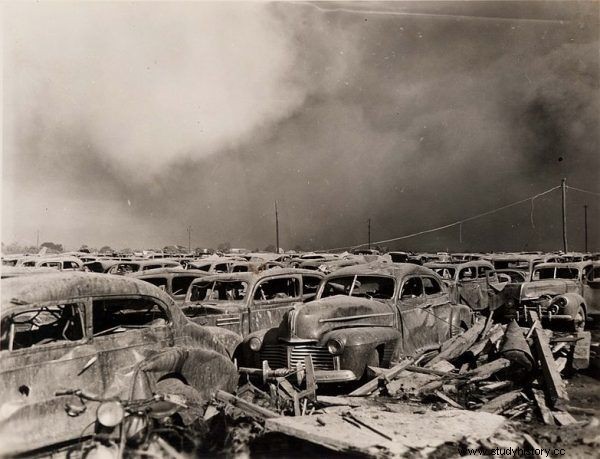
Texas City Disaster
Smoke was first spotted. The fire brigade, unaware of the nature of the materials stored on the ship, started to extinguish the fire with water. This, however, intensified the chemical reactions taking place. The ignited ammonium nitrate, as a result of further reactions, generated huge amounts of heat, which began to turn the water pouring on it into steam. This also applied to the water in the port in the immediate vicinity of the ship.
Water vapor, on the other hand, accelerated the chemical reactions even more. This led to a huge explosion of 2,300 tons of saltpetre, which literally blew up the entire seafront. Several hundred people died in the blink of an eye and thousands were injured. In addition, the explosion created a local tsunami that washed away onlookers gathering nearby.
The blast threw thousands of tons of metal debris into the air, some of which were supposed to travel at supersonic speeds. A 2-ton anchor from the ship was found almost 3 kilometers from the port, and another 5-ton anchor flew over 800 meters. In the city of Galveston, 16 kilometers away, people in the streets were knocked by a shock wave, and in Houston, 60 kilometers from the epicenter, windows were scattered. Minor quakes were recorded in Louisiana, 400 km away. The power of the explosion was 1/5 of the bomb dropped on Hiroshima a few years earlier. In addition, the toxic and dense dust blown into the air fell for many days in a diameter of many kilometers around Texas City, causing further losses.
It would seem that such a tragedy may become a certain warning for humanity, however, as we can see from all the examples given in this article, it is a deceptive hope.
7. Explosion in Beirut
This is without a doubt the most recent example of human myopia. On August 4, 2020, there was an explosion of 2,700 tons of ammonium nitrate in the port of Lebanon (i.e. several hundred tons more than in Texas) , completely destroying the port and surrounding buildings.
The saltpeter, stored in one of the port's warehouses, was confiscated in 2014 by Lebanese authorities from a detained ship. Since its storage, customs have repeatedly reported the need to transport hazardous materials elsewhere, reporting the scale of the threat, but the appeals were always ignored.
The direct cause of the crash, reported by Al-Jadid TV, gives goosebumps. The port security services ordered the warehouse door to be welded to prevent theft . The consequences of this absurd idea reached the whole of Beirut just a few hours after the completion of the works.

Quite recently, there was a massive explosion in Beirut
At 5:55 pm the fire brigade was informed about a fireworks fire in one of the warehouses in the port. When the relevant services arrived, it turned out that the fire was much bigger than expected, so reinforcements were called. Dozens of recordings circulating on the Internet show clouds of black smoke floating above the port and a series of small explosions. Moments later, the city is shaken by a huge explosion, and the shock wave destroys the nearest buildings and breaks windows in virtually the entire city. The balance of losses and casualties is huge and is growing day by day. As of August 10, it has been reported that 220 victims, 110 missing and more than 6,000 injured. About 300,000 people lost a roof over their heads.
A week after the catastrophe, Lebanese Prime Minister Hassan Diab and the government resigned, informing at the same time that there was enormous corruption behind the neglect and, consequently, the explosion in the port. Although the word "huge" does not in any way convey the enormity of the corruption that has been going on in this country for years. Ineffective governments and decades of ignoring the basic needs of an increasingly poorer society have brought Lebanon to the brink of bankruptcy, and the recent explosion has brought the specter of a humanitarian disaster. The situation is exacerbated by street protests against the government, which turned into riots.
So you can see that modern civilization does not learn lessons from its history, making the same mistakes over and over again, in which the innocent die and the natural environment is irretrievably destroyed.
